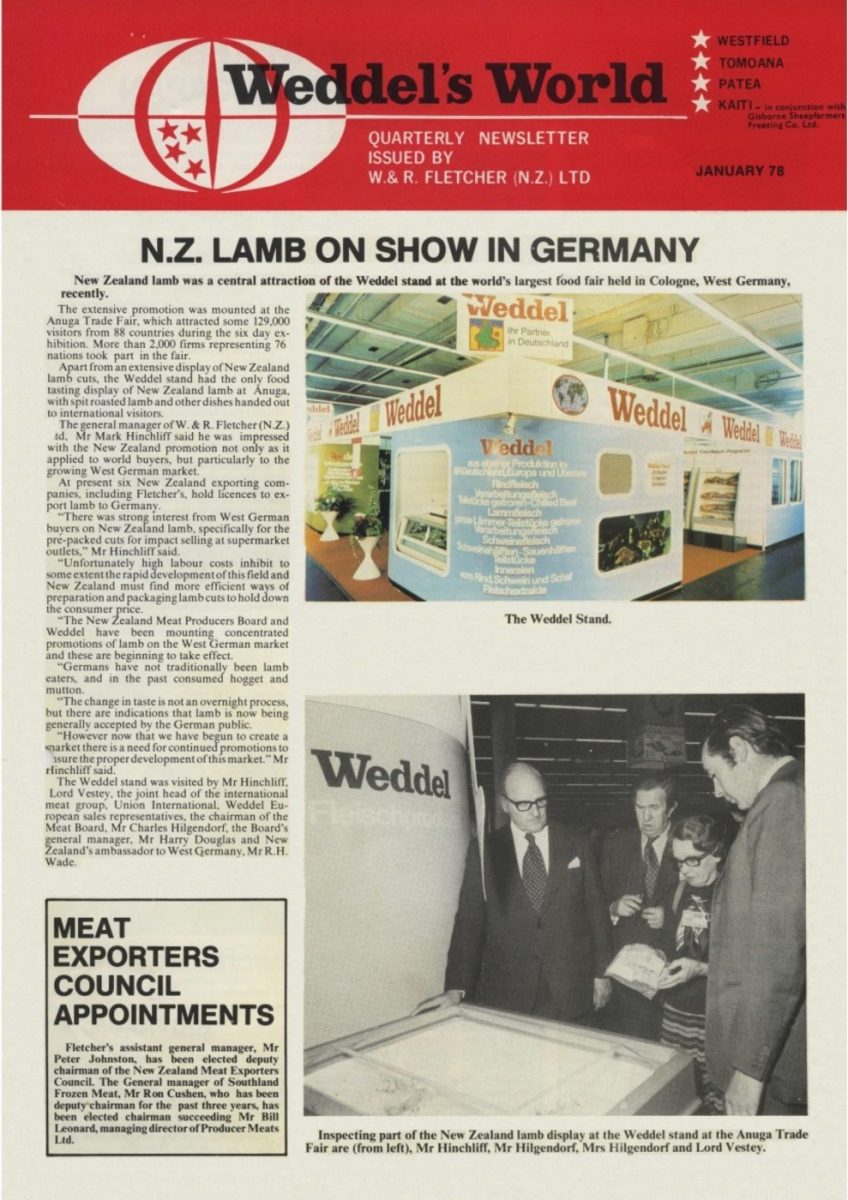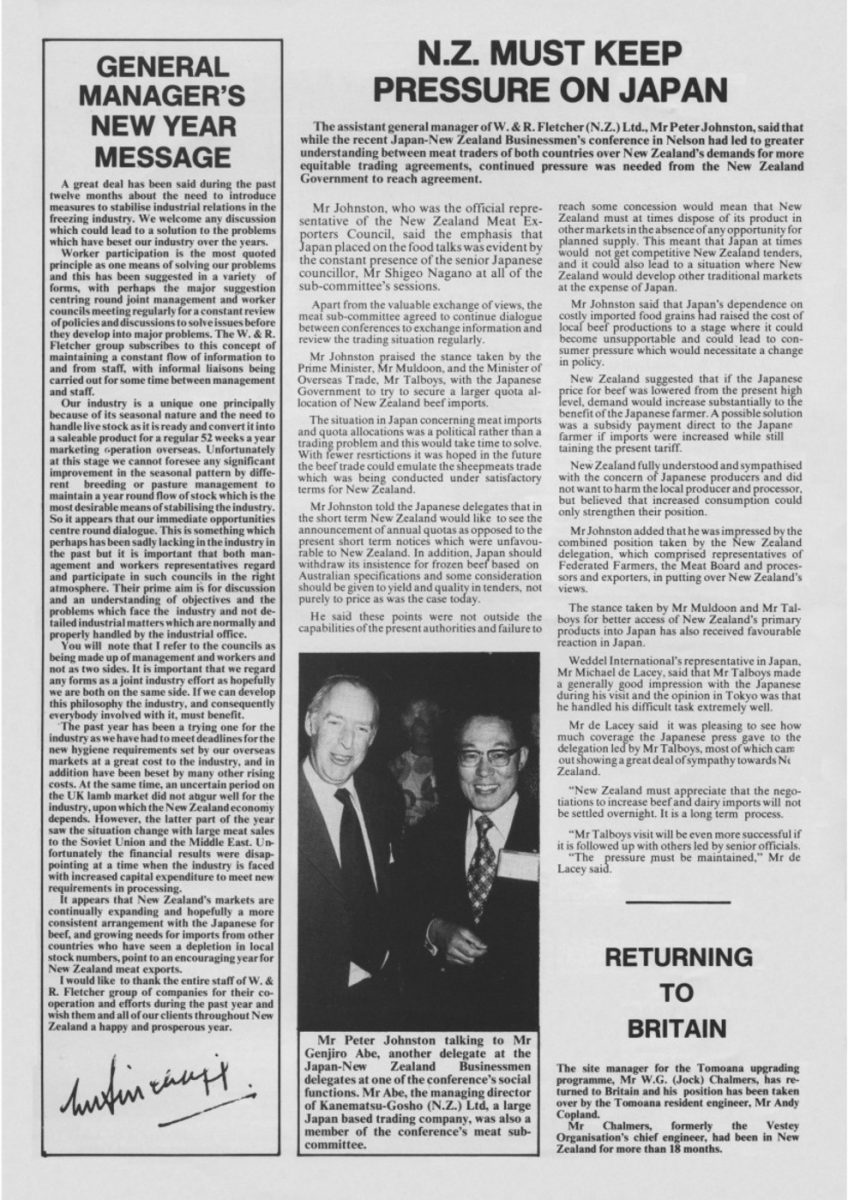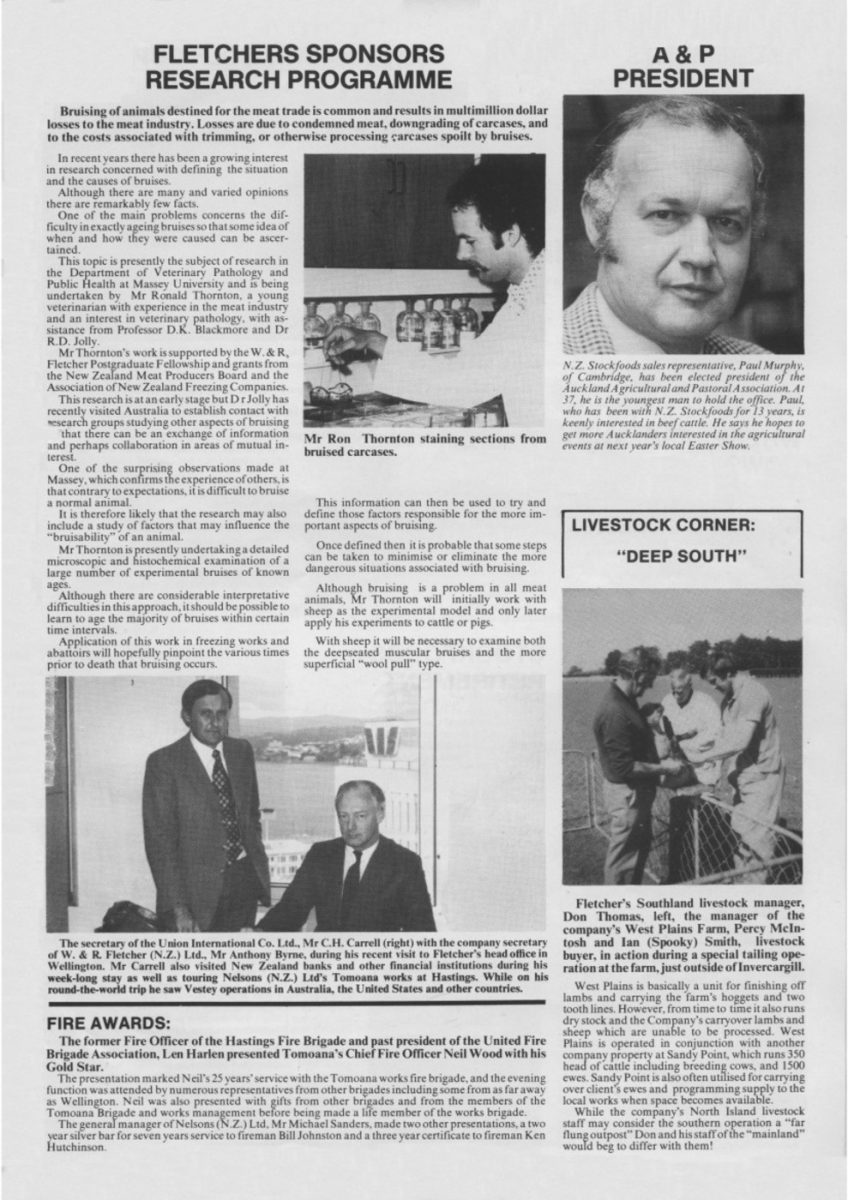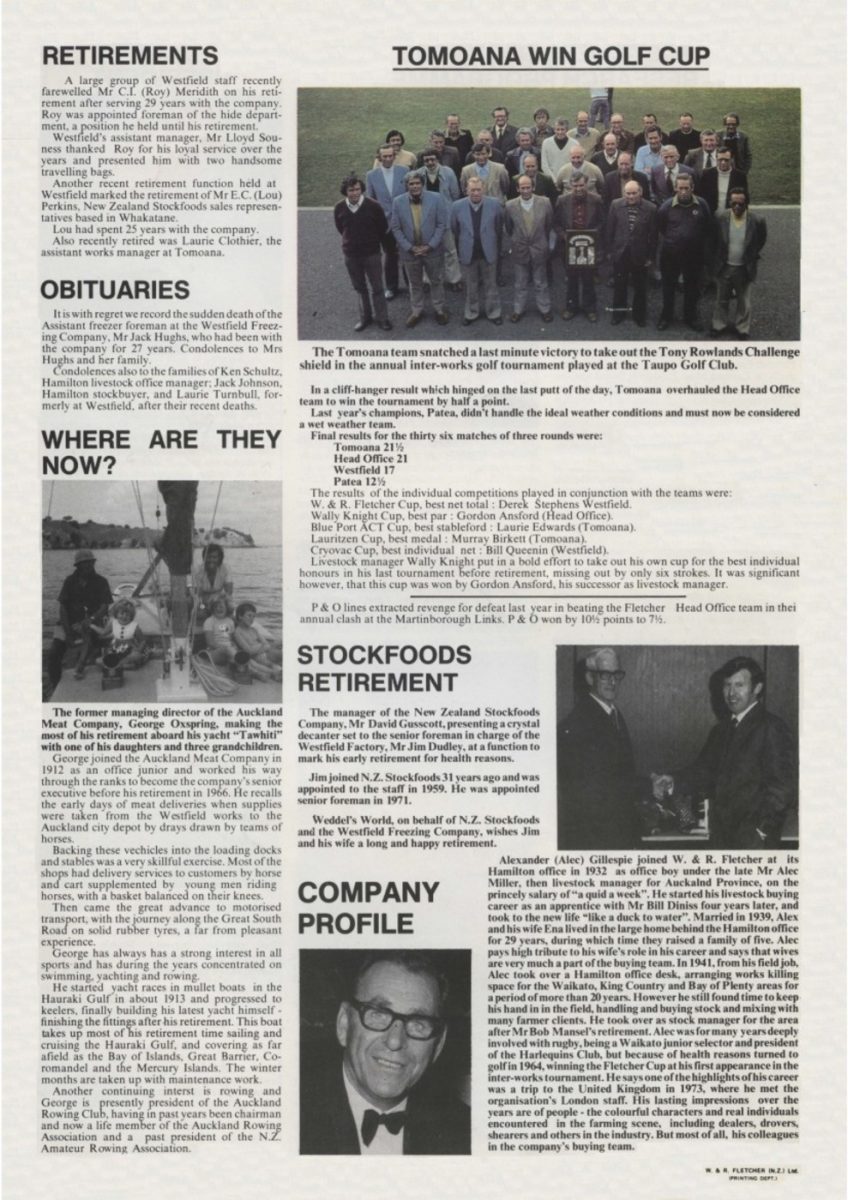- Home
- Collections
- SANDERS MJ
- Weddel's World
- Weddel's World 1978- January
Weddel’s World 1978- January
Weddel’s World
WESTFIELD
TOMOANA
PATEA
KAITI – in conjunction with Gisborne Sheepfarmers Freezing C. Ltd.
QUARTERLY NEWSLETTER
ISSUED BY
W. & R. FLETCHER (N.Z.) LTD
JANUARY 78
N.Z. LAMB ON SHOW IN GERMANY
New Zealand lamb was a central attraction of the Weddel stand at the world’s largest food fair held in Cologne, West Germany, recently.
The extensive promotion was mounted at the Anuga Trade Fair, which attracted some 129,000 visitors from 88 countries during the six day exhibition. More than 2,000 firms representing 76 nations took part in the fair.
Apart from an extensive display of New Zealand lamb cuts, the Weddel stand had the only food tasting display of New Zealand lamb at Anuga, with spit roasted lamb and other dishes handed out to international visitors.
The general manager of W. & R. Fletcher (N.Z.) Ltd, Mr Mark Hinchliff said he was impressed with the New Zealand promotion not only as it applied to world buyers, but particularly to the growing West German market.
At present six New Zealand exporting companies, including Fletcher’s, hold licences to export lamb to Germany.
“There was strong interest from West German buyers on New Zealand lamb, specifically for the pre-packed cuts for impact selling at supermarket outlets,” Mr Hinchliff said.
“Unfortunately high labour costs inhibit to some extent the rapid development of this field and New Zealand must find more efficient ways of preparation and packaging lamb cuts to hold down the consumer price.
“The New Zealand Meat Producers Board and Weddel have been mounting concentrated promotions of lamb on the West German market and these are beginning to take effect.
“Germans have not traditionally been lamb eaters, and in the past consume hogget and mutton.
“The change in taste is not an overnight process, but there are indications that lamb is now being generally accepted by the German public.
“However now that we have begun to create a market there is a need for continued promotions to insure the proper development of this market.” Mr Hinchliff said.
The Weddel stand was visited by Mr Hinchliff, Lord Vestey, the joint head of the international meat group, Union International, Weddel European sales representatives, the chairman of the Meat Board, Mr Charles Hilgendorf, the Board’s general manager, Mr Harry Douglas and New Zealand’s ambassador to West Germany, Mr R. H. Wade.
MEAT EXPORTERS COUNCIL APPOINTMENTS
Fletcher’s assistant general manager, Mr Peter Johnston, has been elected deputy chairman of the New Zealand Meat Exporters Council. The General manager of Southland Frozen Meat, Mr Ron Cushen, who has been deputy chairman for the past three years, has been elected chairman succeeding Mr Bill Leonard, managing director of Producer Meats Ltd.
Photo captions –
The Weddel Stand
Inspecting part of the New Zealand lamb display at the Weddel stand at the Anuga Trade Fair are (from left), Mr Hinchliff, Mr Hilgendorf, Mrs Hilgendorf and Lord Vestey.

GENERAL MANAGER’S NEW YEAR MESSAGE
A great deal has been said during the past twelve months about the need to introduce measures to stabilise industrial relations in the freezing industry. We welcome any discussion which could lead to a solution to the problems which have beset our industry over the years.
Worker participation is the most quoted principle as one means of solving our problems and this has been suggested in a variety of forms, with perhaps the major suggestion centring round joint management and worker councils meeting regularly for a constant review of policies and discussions to solve issues before they develop into major problems. The W. & R. Fletcher group subscribes to this concept of maintaining a constant flow of information to and from staff, with informal liaisons being carried out for some time between management and staff.
Our industry is a unique one principally because of its seasonal nature and the need to handle live stock as it is ready and convert it into a saleable product for a regular 52 weeks a year marketing operation overseas. Unfortunately at this stage we cannot foresee any significant improvement in the seasonal pattern by different breeding or pasture management to maintain a year round flow of stock which is the most desirable means of stabilising the industry. So it appears that our immediate opportunities centre round dialogue. This is something which perhaps has been sadly lacking in the industry in the past but it is important that both management and workers representatives regard and participate in such councils in the right atmosphere. Their prime aim is for discussion and an understanding of objectives and the problems which face the industry and not detailed industrial matters which are normally and properly handled by the industrial office.
You will note that I refer to the councils as being made up of management and workers and not as two sides. It is important that we regard any forms as a joint industry effort as hopefully we are both on the same side. If we can develop this philosophy the industry, and consequently everybody involved with it, must benefit.
The past year has been a trying one for the industry as we have had to meet deadlines for the new hygiene requirements set by our overseas markets at a great cost to the industry, and in addition have been beset by many other rising costs. At the same time, an uncertain period on the UK lamb market did not augur well for the industry, upon which the New Zealand economy depends. However, the latter part of the year saw the situation change with large meat sales to the Soviet Union and the Middle East. Unfortunately the financial results were disappointing at a time when the industry is faced with increased capital expenditure to meet new requirements in processing.
It appears that New Zealand’s markets are continually expanding and hopefully a more consistent arrangement with the Japanese for beef, and growing needs for imports from other countries who have seen a depletion in local stock numbers, point to an encouraging year for New Zealand meat exports.
I would like to thank the entire staff of W. & R. Fletcher group of companies for their cooperation and efforts during the past year and wish them and all of our clients throughout New Zealand a happy and prosperous year.
M Hinchliff
N.Z. MUST KEEP PRESSURE ON JAPAN
The assistant general manager of W. & R. Fletcher (N.Z.) Ltd., Mr Peter Johnston, said that while the recent Japan-New Zealand Businessmen’s conference in Nelson had led to greater understanding between meat traders of both countries over New Zealand’s demands for more equitable trading agreements, continued pressure was needed from the New Zealand Government to reach agreement.
Mr Johnston, who was the official representative of the New Zealand Meat Exporters Council, said the emphasis that Japan placed on the food talks was evident by the constant presence of the senior Japanese councillor, Mr Shigeo Nagano at all of the sub-committee’s sessions.
Apart from the valuable exchange of views, the meat sub-committee agreed to continue dialogue between conferences to exchange information and review the trading situation regularly.
Mr Johnston praised the stance taken by the Prime Minister, Mr Muldoon, and the Minister of Overseas Trade, Mr Talboys, with the Japanese Government to try to secure a larger quota allocation of New Zealand beef imports.
The situation in Japan concerning meat imports and quota allocations was a political rather than a trading problem and this would take time to solve. With fewer resrtictions [restrictions] it was hoped in the future the beef trade could emulate the sheepmeats trade which was being conducted under satisfactory terms for New Zealand.
Mr Johnston told the Japanese delegates that in the short term New Zealand would like to see the announcement of annual quotas as opposed to the present short term notices which were unfavourable to New Zealand. In addition, Japan should withdraw its insistence for frozen beef based on Australian specifications and some consideration should be given to yield and quality in tenders, not purely to price as was the case today.
He said these points were not outside the capabilities of the present authorities and failure to reach some concession would mean that New Zealand must at times dispose of its product in other markets in the absence of any opportunity for planned supply. This meant that Japan at times would not get competitive New Zealand tenders, and it could also lead to a situation where New Zealand would develop other traditional markets at the expense of Japan.
Mr Johnston said that Japan’s dependence on costly imported food grains had raised the cost of local beef productions to a stage where it could become unsupportable and could lead to consumer pressure which would necessitate a change in policy.
New Zealand suggested that if the Japanese rice for beef was lowered from the present high level, demand would increase substantially to the benefit of the Japanese farmer. A possible solution was a subsidy payment direct to the Japanese farmer if imports were increased while still maintaining the present tariff.
New Zealand fully understood and sympathised with the concern of Japanese producers and did not want to harm the local producer and processor, but believed that increased consumption could only strengthen their position.
Mr Johnston added that he was impressed by the combined position taken by the New Zealand delegation, which comprised representatives of Federated Farmers, the Meat Board and processors and exporters, in putting over New Zealand’s views.
The stance taken by Mr Muldoon and Mr Talboys for better access of New Zealand’s primary products into Japan has also received favourable reaction in Japan.
Weddel International’s representative in Japan, Mr Michael de Lacey, said that Mr Talboys made a generally good impression with the Japanese during his visit and the opinion in Tokyo was that he handled his difficult task extremely well.
Mr de Lacey said it was pleasing to see how much coverage the Japanese press gave to the delegation led by Mr Talboys, most of which came out showing a great deal of sympathy towards New Zealand.
“New Zealand must appreciate that the negotiations to increase beef and dairy imports will not be settled overnight. It is a long term process.
“Mr Talboys visit will be even more successful if it is followed up with others led by senior officials.
“The pressure must be maintained,” Mr de Lacey said.
Photo caption – Mr Peter Johnston talking to Mr Genjiro Abe, another delegate at the Japan-New Zealand Businessmen delegates at one of the conference’s social functions. Mr Abe, the managing director of Kanematsu-Gosho (N.Z.) Ltd, a large Japan based trading company, was also a member of the conference’s meat subcommittee.
RETURNING TO BRITAIN
The site manager for the Tomoana upgrading programme, Mr W. G. (Jock) Chalmers, has returned to Britain and his position has been taken over by the Tomoana resident engineer, Mr Andy Copland.
Mr Chalmers, formerly the Vestey Organisation’s chief engineer, had been in New Zealand for more than 18 months.

FLETCHERS SPONSORS RESEARCH PROGRAMME
Bruising of animals destined for the meat trade is common and results in multimillion dollar losses to the meat industry. Losses are due to condemned meat, downgrading of carcases, and to the costs associated with trimming, or otherwise processing carcases spoilt by bruises.
In recent years there has been a growing interest in research concerned with defining the situation and the causes of bruises.
Although there are many and varied opinions there are remarkably few facts.
One of the main problems concerns the difficulty in exactly ageing bruises so that some idea of when and how they were caused can be ascertained.
This topic is presently the subject of research in the Department of Veterinary Pathology and Public Health at Massey University and is being undertaken by Mr Ronald Thornton, a young veterinarian with experience in the meat industry and an interest in veterinary pathology, with assistance from Professor D. K. Blackmore and Dr R.D. Jolly.
Mr Thornton’s work is supported by the W. & R., Fletcher Postgraduate Fellowship and grants from the New Zealand Meat Producers Board and the Association of New Zealand Freezing Companies.
This research is at an early stage but Dr Jolly has recently visited Australia to establish contact with research groups studying other aspects of bruising that there can be an exchange of information and perhaps collaboration in areas of mutual interest.
One of the surprising observations made at Massey, which confirms experience of others, is that contrary to expectations, it is difficult to bruise a normal animal.
It is therefore likely that the research may also include a study of factors that may influence the “bruisability” of an animal.
Mr Thornton is presently undertaking a detailed microscopic and histochemical examination of a large number of experimental bruises of known ages.
Although there are considerable interpretative difficulties in this approach, it should be possible to learn to age the majority of bruises within certain time intervals.
Application of this work in freezing works and abattoirs will hopefully pinpoint the various times prior to death that bruising occurs.
This information can then be used to try and define those factors responsible for the more important aspects of bruising.
Once defined then it is probable that some steps can be taken to minimise or eliminate the more dangerous situations associated with bruising.
Although bruising is a problem in all meat animals, Mr Thornton will initially work with sheep as the experimental model and only later apply his experiments to cattle or pigs.
With sheep it will be necessary to examine both the deepseated muscular bruises and the more superficial “wool pull” type.
Photo caption – Mr Ron Thornton staining sections from bruised carcases.
The secretary of the Union International Co. Ltd., Mr C. H. Carrell (right) with the company secretary of W. & R. Fletcher (N.Z.) Ltd., Mr Anthony Byrne, during his recent visit to Fletcher’s head office in Wellington. Mr Carrell also visited New Zealand banks and other financial institutions during his week-long stay as well as touring Nelsons (N.Z.) Ltd’s Tomoana works at Hastings. While on his round-the-world trip he saw Vestey operations in Australia, the United States and other countries.
FIRE AWARDS:
The former Fire Officer of the Hastings Fire Brigade and past president of the United Fire Brigade Association, Len Harlen presented Tomoana’s Chief Fire Officer Neil Wood with his Gold Star.
The presentation marked Neil’s 25 years’ service with the Tomoana works fire brigade, and the evening function was attended by numerous representatives from other brigades including some from as far away as Wellington. Neil was also presented with gifts from other brigades and from the members of the Tomoana Brigade and works management before being made a life member of the works brigade.
The general manager of Nelsons (NZ) Ltd, Mr Michael Sanders, made two other presentations, a two year silver bar for seven years service to fireman Bill Johnston and a three year certificate to fireman Ken Hutchinson.
A & P PRESIDENT
N. Z. Stockfoods sales representative, Paul Murphy, of Cambridge, has been elected president of the Auckland Agricultural and Pastoral Association. At 37, he is the youngest man to hold the office. Paul, who has been with N. Z. Stockfoods for 13 years, is keenly interested in beef cattle. He says he hopes to get more Aucklanders interested in the agricultural events at next year’s local Easter Show.
LIVESTOCK CORNER: “DEEP SOUTH”
Fletcher’s Southland livestock manager, Don Thomas, left, the manager of the company’s West Plains Farm, Percy McIntosh and Ian (Spooky) Smith, livestock buyer, in action during a special tailing operation at the farm, just outside of Invercargill.
West Plains is basically a unit for finishing off lambs and carrying the farm’s hoggets and two tooth lines. However, from time to time it also runs dry stock and the Company’s carryover lambs and sheep which are unable to be processed. West Plains is operated in conjunction with another company property at Sandy Point, which runs 350 head of cattle including breeding cows, and 1500 ewes. Sandy Point is also often utilised for carrying over client’s ewes and programming supply to the local works when space becomes available.
While the company’s North Island livestock staff may consider the southern operation a “far flung outpost” Don and his staff of the “mainland” would beg to differ with them!

RETIREMENTS
A large group of Westfield staff recently farewelled Mr C. I. (Roy) Meridith on his retirement after serving 29 years with the company. Roy was appointed foreman of the hide department, a position he held until his retirement.
Westfield’s assistant manager, Mr Lloyd Souness thanked Roy for his loyal service over the years and presented him with two handsome travelling bags.
Another recent retirement function held at Westfield marked the retirement of Mr E. C. (Lou) Perkins, New Zealand Stockfoods sales representatives based in Whakatane.
Lou had spent 25 years with the company.
Also recently retired was Laurie Clothier, the assistant works manager at Tomoana.
OBITUARIES
It is with regret we record the sudden death of the Assistant freezer foreman at the Westfield Freezing Company, Mr Jack Hughs, who had been with the company for 27 years. Condolences to Mrs Hughs and her family.
Condolences also to the families of Ken Schultz, Hamilton livestock office manager; Jack Johnson, Hamilton stockbuyer, and Laurie Turnbull, formerly at Westfield, after their recent deaths.
WHERE ARE THEY NOW?
The former managing director of the Auckland Meat Company, George Oxspring, making the most of his retirement aboard his yacht “Tawhiti” with one of his daughters and three grandchildren.
George joined the Auckland Meat Company in 1912 as an office junior and worked his way through the ranks to become the company’s senior executive before his retirement in 1966. He recalls the early days of meat deliveries when supplies were taken from the Westfield works to the Auckland city depot by drays drawn by teams of horses.
Backing these vechicles [vehicles] into the loading docks and stables was a very skillful exercise. Most of the shops had delivery services to customers by horse cart supplemented by young men riding horses, with a basket balanced on their knees.
Then came the great advance to motorised transport, with the journey along the Great South Road on solid rubber tyres, a far from pleasant experience.
George has always has a strong interest in all sports and has during the years concentrated on swimming, yachting and rowing.
He started yacht races in mullet boats in the Hauraki Gulf in about 1913 and progressed to keelers, finally building his latest yacht himself – finishing the fittings after his retirement. This boat takes up most of his retirement time sailing and cruising the Hauraki Gulf, and covering as far afield as the Bay of Islands, Great Barrier, Coromandel and the Mercury Islands. The winter months are taken up with maintenance work.
Another continuing interst [interest] is rowing and George is presently president of the Auckland Rowing Club, having in past years been chairman and now a life member of the Auckland Rowing Association and a past president of the NZ. Amateur Rowing Association.
TOMOANA WIN GOLF CUP
The Tomoana team snatched a last minute victory to take out the Tony Rowlands Challenge shield in the annual inter-works golf tournament played at the Taupo Golf Club.
In a cliff-hanger result which hinged on the last putt of the day, Tomoana overhauled the Head Office team to win the tournament by half a point.
Last year’s champions, Patea, didn’t handle the ideal weather conditions and must now be considered a wet weather team.
Final results for the thirty six matches of three rounds were:
Tomoana 21½
Head Office 21
Westfield 17
Patea 12½
The results of the individual competitions played in conjunction with the teams were:
W. & R. Fletcher Cup, best net total : Derek Stephens Westfield.
Wally Knight Cup, best par : Gordon Ansford (Head Office).
Blue Port ACT Cup, best stableford : Laurie Edwards (Tomoana).
Lauritzen Cup, best medal : Murray Birkett (Tomoana).
Cryovac Cup, best individual net : Bill Queenin (Westfield).
Livestock manager Wally Knight put in a bold effort to take out his own cup for the best individual honours in his last tournament before retirement, missing out by only six strokes. It was sign however, that this cup was won by Gordon Ansford, his successor as livestock manager.
P & O lines extracted revenge for defeat last year in beating the Fletcher Head Office team in their annual clash at the Martinborough Links. P & O won by 10½ points to 7½.
STOCKFOODS RETIREMENT
The manager of the New Zealand Stockfoods Company, Mr David Gusscott, presenting a crystal decanter set to the senior foreman in charge of the Westfield Factory, Mr Jim Dudley, at a function to mark his early retirement for health reasons.
Jim joined N.Z. Stockfoods 31 years ago and was appointed to the staff in 1959. He was appointed senior foreman in 1971.
Weddel’s World, on behalf of NZ. Stockfoods and the Westfield Freezing Company, wishes Jim and his wife a long and happy retirement.
COMPANY PROFILE
Alexander (Alec) Gillespie joined W. & R. Fletcher at its Hamilton office in 1932 as office boy under the late Mr Alec Miller, then livestock manager for Auckalnd [Auckland] Province, on the princely salary of “a quid a week”. He started his livestock buying career as an apprentice with Mr Bill Diniss four years later, and took to the new life “like a duck to water”. Married in 1939, Alex and his wife Ena lived in the large home behind the Hamilton office for 29 years, during which time they raised a family of five. Alec pays high tribute to his wife’s role in his career and says that wives are very much a part of the buying team. In 1941, from his field job, Alec took over a Hamilton office desk, arranging works killing space for the Waikato, King Country and Bay of Plenty areas for a period of more than 20 years. However he still found time to keep his hand in in the field, handling and buying stock and mixing with many farmer clients. He took over as stock manager for the area after Mr Bob Mansel’s retirement. Alec was for many years deeply involved with rugby, being a Waikato junior selector and president of the Harlequins Club, but because of health reasons turned to golf in 1964, winning the Fletcher Cup at his first appearance in the inter-works tournament. He says one of the highlights of his career was a trip to the United Kingdom in 1973, where he met the organisation’s London staff. His lasting impressions over the years are of people – the colourful characters and real individuals, encountered in the farming scene, including dealers, drovers, shearers and others in the industry. But most of all, his colleagues in the company’s buying team.
W & R. FLETCHER (N.Z.) Ltd.
(PRINTING DEPT.)

Non-commercial use

This work is licensed under a Attribution-NonCommercial 3.0 New Zealand (CC BY-NC 3.0 NZ).
Commercial Use
Please contact us for information about using this material commercially.Can you help?
The Hawke's Bay Knowledge Bank relies on donations to make this material available. Please consider making a donation towards preserving our local history.
Visit our donations page for more information.
Description
Surnames in this newsletter – Abe, Ansford, Birkett, Blackmore, Bryne, Carrell, Chalmers, Clothier, Cushen, de Lacey, Diniss, Douglas, Dudley, Edwards, Gillespie, Gusscott, Harlen, Hilgendorf, Hinchliff, Hughs, Hutchinson, Johnston, Jolly, Knight, Leonard, Mansel, McIntosh, Meridith, Miller, Muldoon, Murphy, Nagano, Oxspring, Perkins, Queenin, Sanders, Schultz, Smith, Souness, Stephens, Talboys, Thomas, Thornton, Turnbull, Vestey, Wade, Wood










Do you know something about this record?
Please note we cannot verify the accuracy of any information posted by the community.